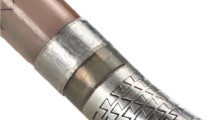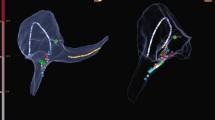Summary.
Due to its variable origin success for ablation of ectopic atrial tachycardia (EAT) has been difficult to achieve using conventional mapping and ablation strategies. In contrast, no information in the literature is available about the use of a nonfluoroscopic, 3-dimensional electroanatomic mapping system (CARTO™) combined with the cooled ablation technology creating deeper lesions in experimental studies compared to standard catheters. In 20 consecutive patients (15 female; age 52.5 ± 15.4 years), a single focus responsible for clinical EAT has been mapped. Twelve EATs were located in the right atrium, whereas 8 foci were left sided including 3 origins within a pulmonary vein (PV). Due to the reported development of PV stenosis in the ablative treatment of focal atrial fibrillation, direct ablation applied inside the PV was avoided. Instead, PV-disconnection achieved by the use of a Lasso™ catheter in 1 case and by circumferential ablation around the PV in 2 other patients was preferred. In 2 patients, ablation was not attempted because of an origin located directly in the area of the atrioventricular node. In another case, CARTO™ mapping was stopped due to persistent mechanical termination of the tachycardia with no possibility of reinduction. In the latter, ablation was performed in sinus rhythm at the earliest mapped site before terminating. Three weeks later another episode of EAT was noted in this patient. In the remaining 17 cases, ablation was associated with acute success and no recurrences of sustained tachycardia in all patients. Mean duration time was 192 ± 53.3 min (right atrium 161 ± 37.9 min; left atrium 229.6 ± 46.2 min), and average fluoroscopic time was 22.8 ± 9.7 min (right atrium 17.1 ± 6.2 min; left atrium 29.8 ± 8.9 min). There was no incidence of serious complications associated with this procedure. In conclusions, electroanatomical mapping including cooled ablation was a safe and feasible strategy in treating EATs. The benefit of this technique may imply the combination of both precise localization of the focus and effective applications of radiofrequency pulses, thereby minimizing acute failures or reablation. Due to the time consuming point by point data acquisition, the ability to generate precise maps demonstrating the earliest activation at their exact anatomical location can be limited by transient or persistent termination of the tachycardia.
Zusammenfassung.
Aufgrund ihres variablen Ursprungs ist eine erfolgreiche Katheterablation von ektopen atrialen Tachykardien (EAT) mittels konventioneller Strategie oft schwierig. Keine Studiendaten existieren in diesem Zusammenhang über den kombinierten Einsatz eines 3-dimensionalen elektroanatomischen Mappingsystems (CARTO™) mit der gekühlten Ablation, die im experimentellen Vergleich zu Standardkathetern tiefere Läsionen erzielen kann. Bei 20 Patienten (15 weiblich; Durchschnittsalter 52,5 ± 15,4 Jahre) wurden jeweils ein für die klinische EAT verantwortlicher Fokus gemappt. Zwölf waren rechts-atrial gelegen, 8 linksseitig, 3 davon innerhalb einer Pulmonalvene (PV). Aufgrund jüngster Berichte über die mögliche Entstehung von PV-Stenosen bzw. -Verschlüssen in der ablativen Therapie von fokalem Vorhofflimmern wurde bei letzteren auf eine direkte Ablation des Fokus innerhalb der PV verzichtet und stattdessen eine PV-Diskonnektion (1× unter Anwendung eines Lasso™-Katheters, 2× mittels zirkumferentieller Ablation) durchgeführt. In einem anderen Fall musste das Mapping aufgrund persisitierender mechanischer Terminierung der Tachykardie ohne Möglichkeit der Reinduktion abgebrochen werden. Hier erfolgte im Sinusrhythmus die Abgabe von 3 Impulsen am Ort der vor Terminierung frühesten gemappten Aktivierung. Drei Wochen später kam es zu einem erneuten Auftreten der EAT. Alle verbliebenen 17 Patienten wurden erfolgreich abladiert und hatten im Follow-up kein erneutes Auftreten anhaltender Tachykardien. Die durchschnittliche Untersuchungszeit betrug 192 ± 53,3 Minuten (rechts-atrial 161 ± 37,9 Min.; links-atrial 229,6 ± 46,2 Min.), die durchschnittliche Durchleuchtungszeit war 22,8 ± 9,7 Minuten (rechts-atrial 17,1 ± 6,2 Min.; links-atrial 29,8 ± 8,9 Min.). Es kam zu keinen Komplikationen. Zusammenfassend erwies sich der kombinierte Einsatz eines elektroanatomischen Mappings mit der gekühlten Ablation als eine sichere und durchführbare Strategie in der Behandlung komplexer EAT’s. Der Vorteil dieser Technik scheint in der Möglichkeit zur genauen Identifikation des Fokus verbunden mit der Applikation effektiver Radiofrequenz-Impulse zu liegen. Aufgrund der manchmal zeitaufwendigen „Punkt für Punkt“-Datenaufnahme zur Erstellung eines präzisen elektroanatomischen Maps kann das Darstellen der frühesten Aktivierung an der exakten anatomischen Lokalisation durch transiente oder persistierende Terminierung der Tachykardie eingeschränkt sein.
Similar content being viewed by others
Author information
Authors and Affiliations
Corresponding author
Rights and permissions
About this article
Cite this article
Horlitz, M., Schley, P., Shin, DI. et al. Klinische Erfahrungen mit der gekühlten Radiofrequenzablation ektoper atrialer Tachykardien unter Einsatz eines elektroanatomischen Mappingsystems. Z Kardiol 93, 137–146 (2004). https://doi.org/10.1007/s00392-004-1034-8
Received:
Accepted:
Issue Date:
DOI: https://doi.org/10.1007/s00392-004-1034-8




